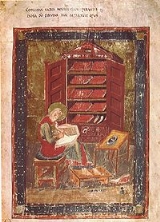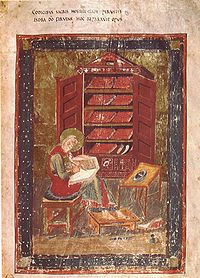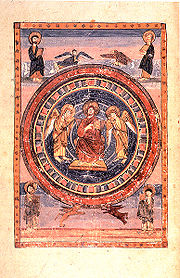
Codex Amiatinus
Encyclopedia

Scribal abbreviation
Scribal abbreviations are the abbreviations used by ancient and mediæval scribes writing in Latin and, later, in Greek and Old Norse...
A, is the earliest surviving manuscript
Manuscript
A manuscript or handwrite is written information that has been manually created by someone or some people, such as a hand-written letter, as opposed to being printed or reproduced some other way...
of the nearly complete Bible in the Latin Vulgate
Vulgate
The Vulgate is a late 4th-century Latin translation of the Bible. It was largely the work of St. Jerome, who was commissioned by Pope Damasus I in 382 to make a revision of the old Latin translations...
version, and is considered to be the most accurate copy of St. Jerome's text. It is missing the Book of Baruch. It was produced in the Anglo-Saxon
Anglo-Saxon
Anglo-Saxon may refer to:* Anglo-Saxons, a group that invaded Britain** Old English, their language** Anglo-Saxon England, their history, one of various ships* White Anglo-Saxon Protestant, an ethnicity* Anglo-Saxon economy, modern macroeconomic term...
kingdom of Northumbria
Northumbria
Northumbria was a medieval kingdom of the Angles, in what is now Northern England and South-East Scotland, becoming subsequently an earldom in a united Anglo-Saxon kingdom of England. The name reflects the approximate southern limit to the kingdom's territory, the Humber Estuary.Northumbria was...
as a gift for the Pope, and dates to the start of the 8th century. The Codex is also a fine specimen of medieval calligraphy
Calligraphy
Calligraphy is a type of visual art. It is often called the art of fancy lettering . A contemporary definition of calligraphic practice is "the art of giving form to signs in an expressive, harmonious and skillful manner"...
, and is now kept at Florence
Florence
Florence is the capital city of the Italian region of Tuscany and of the province of Florence. It is the most populous city in Tuscany, with approximately 370,000 inhabitants, expanding to over 1.5 million in the metropolitan area....
in the Biblioteca Medicea Laurenziana (Cat. Sala Studio 6).
Description

It contains Epistula Hieronymi ad Damasum, Prolegomena to the four Gospels.
Some consider it, with White, as perhaps "the finest book in the world"; still there are several manuscripts which are as beautifully written and have besides, like the Book of Kells
Book of Kells
The Book of Kells is an illuminated manuscript Gospel book in Latin, containing the four Gospels of the New Testament together with various prefatory texts and tables. It was created by Celtic monks ca. 800 or slightly earlier...
or Lindisfarne Gospels
Lindisfarne Gospels
The Lindisfarne Gospels is an illuminated Latin manuscript of the gospels of Matthew, Mark, Luke and John in the British Library...
, those exquisite ornaments of which Amiatinus is devoid. It qualifies as an illuminated manuscript
Illuminated manuscript
An illuminated manuscript is a manuscript in which the text is supplemented by the addition of decoration, such as decorated initials, borders and miniature illustrations...
as it has some decoration including two full-page miniatures, but these show little sign of the usual insular style
Insular art
Insular art, also known as Hiberno-Saxon art, is the style of art produced in the post-Roman history of Ireland and Great Britain. The term derives from insula, the Latin term for "island"; in this period Britain and Ireland shared a largely common style different from that of the rest of Europe...
of Northumbrian art and are clearly copied from Late Antique originals. It contains 1040 leaves of strong, smooth vellum
Vellum
Vellum is mammal skin prepared for writing or printing on, to produce single pages, scrolls, codices or books. It is generally smooth and durable, although there are great variations depending on preparation, the quality of the skin and the type of animal used...
, fresh-looking today despite their great antiquity, arranged in quires of four sheets, or quaternions. It is written in uncial
Uncial
Uncial is a majuscule script commonly used from the 3rd to 8th centuries AD by Latin and Greek scribes. Uncial letters are written in either Greek, Latin, or Gothic.-Development:...
characters, large, clear, regular, and beautiful, two columns to a page, and 43 or 44 lines to a column. A little space is often left between words, but the writing is in general continuous. The text is divided into sections, which in the Gospels correspond closely to the Ammonian Sections
Ammonian Sections
Eusebian canons or Eusebian sections, also known as Ammonian Sections, are the system of dividing the four Gospels used between late Antiquity and the Middle Ages. The divisions into chapters and verses used in modern texts date only from the 13th and 16th centuries, respectively...
. There are no marks of punctuation, but the skilled reader was guided into the sense by stichometric
Stichometry
Stichometry is a term applied to the measurement of ancient texts by στίχοι or verses of a fixed standard length.It was the custom of the Greeks and Romans to estimate the length of their literary works by measured lines...
, or verse-like, arrangement into coda and commata, which correspond roughly to the principal and dependent clauses of a sentence. From this manner of writing the scribe is believed to have been modeled upon the Codex Grandior
Codex Grandior
The Codex Grandior was a large single volume copy of the Bible in an Old Latin translation that was made for or by Cassiodorus, for his monastic foundation at Vivarium. This codex was in Northumbria at the time of Bede. It was probably acquired in Italy by Benedict Biscop or Ceolfrid in 678 for...
of Cassiodorus
Cassiodorus
Flavius Magnus Aurelius Cassiodorus Senator , commonly known as Cassiodorus, was a Roman statesman and writer, serving in the administration of Theodoric the Great, king of the Ostrogoths. Senator was part of his surname, not his rank.- Life :Cassiodorus was born at Scylletium, near Catanzaro in...
, but it may go back, perhaps, even to St. Jerome.
Originally three copies of the Bible were commissioned by Ceolfrid
Ceolfrid
Saint Ceolfrid was an Anglo-Saxon Christian abbot and saint. He is best known as the warden of Bede from the age of seven until his death in 716. He was the Abbot of Monkwearmouth-Jarrow Abbey, and a major contributor to the project Codex Amiatinus...
in 692. This date has been established as the double monastery
Double monastery
A double monastery is an institution combining a separate monastery for monks and an abbey for nuns. Examples include Coldingham Monastery in Scotland, and Einsiedeln Abbey and Fahr Abbey in Switzerland, controlled by the abbot of Einsiedeln...
of Wearmouth-Jarrow secured a grant of additional land to raise the 2000 head of cattle needed to produce the vellum
Vellum
Vellum is mammal skin prepared for writing or printing on, to produce single pages, scrolls, codices or books. It is generally smooth and durable, although there are great variations depending on preparation, the quality of the skin and the type of animal used...
. Bede
Bede
Bede , also referred to as Saint Bede or the Venerable Bede , was a monk at the Northumbrian monastery of Saint Peter at Monkwearmouth, today part of Sunderland, England, and of its companion monastery, Saint Paul's, in modern Jarrow , both in the Kingdom of Northumbria...
was most likely involved in the compilation. Ceolfrid accompanied one copy intended as a gift to Pope Gregory II, but he died on route to Rome. The book later appears in the 9th century in Abbey of the Saviour
Abbey of the Saviour
The Abbey of the Saviour is an abbey in the town of Abbadia San Salvatore, Tuscany, Italy, which is named after the Abbey.The traditional account of its origin indicates that the Lombard king Ratchis founded the abbey in AD 743, entrusting it to the Benedictines...
, Monte Amiata in Tuscany
Tuscany
Tuscany is a region in Italy. It has an area of about 23,000 square kilometres and a population of about 3.75 million inhabitants. The regional capital is Florence ....
(hence the description "Amiatinus"), where it remained until 1786 when it passed to the Laurentian Library
Laurentian Library
The Laurentian Library is a historical library in Florence, Italy, containing a repository of more than 11,000 manuscripts and 4,500 early printed books...
in Florence
Florence
Florence is the capital city of the Italian region of Tuscany and of the province of Florence. It is the most populous city in Tuscany, with approximately 370,000 inhabitants, expanding to over 1.5 million in the metropolitan area....
. The dedication page had been altered and the librarian Angelo Maria Bandini
Angelo Maria Bandini
Angelo Maria Bandini was an Italian author and librarian born in Florence.Having been left an orphan in his infancy, he was supported by his uncle, Giuseppe Bandini, a lawyer of some note. He received his education among the Jesuits, and showed a special inclination for the study of antiquities...
suggested that the author was Servandus, a follower of St. Benedict
Benedict of Nursia
Saint Benedict of Nursia is a Christian saint, honored by the Roman Catholic Church as the patron saint of Europe and students.Benedict founded twelve communities for monks at Subiaco, about to the east of Rome, before moving to Monte Cassino in the mountains of southern Italy. There is no...
, and was produced at Monte Cassino
Monte Cassino
Monte Cassino is a rocky hill about southeast of Rome, Italy, c. to the west of the town of Cassino and altitude. St. Benedict of Nursia established his first monastery, the source of the Benedictine Order, here around 529. It was the site of Battle of Monte Cassino in 1944...
around the 540s. This claim was accepted for the next hundred years, establishing it as the oldest copy of the Vulgate, but scholars in Germany noted the similarity to 9th c. texts. In 1888 Giovanni Battista de Rossi
Giovanni Battista de Rossi
Giovanni Battista de Rossi was an Italian archaeologist, famous outside his field for his rediscovery of early Christian catacombs.-Life and works:He was born in Rome...
established that the Codex was related to the Bibles mentioned by Bede. This also established that Amiatinus was related to the Greenleaf Bible fragment in the British Library
British Library
The British Library is the national library of the United Kingdom, and is the world's largest library in terms of total number of items. The library is a major research library, holding over 150 million items from every country in the world, in virtually all known languages and in many formats,...
. Although de Rossi's attribution removed 150 years from the age of the Codex, it remained the oldest version of the Vulgate.
See also
- List of New Testament Latin manuscripts
- Celt (tool)Celt (tool)Celt is an archaeological term used to describe long thin prehistoric stone or bronze adzes, other axe-like tools, and hoes.-Etymology:The term "celt" came about from what was very probably a copyist's error in many medieval manuscript copies of Job 19:24 in the Latin Vulgate Bible, which became...
– a famous mistake in most Vulgates, not found in this copy
Further reading
Text- Ferdinand Florens Fleck, Novum Testamentum Vulgatae editionis juxta textum Clementis VIII. Romanum ex Typogr. Apost. Vatic. A 1592 accurate expressum (Lipsiae 1840).
- Constantinus Tischendorf, Codex Amiatinus. Novum Testamentum Latine interpreter Hieronymo, (Lipsiae 1854).
- The City and the Book: International Conference Proceedings, Florence, 2001 http://www.florin.ms/aleph.html
- Alphabet and Bible: From the Margins to the Centre. Paper at Monte Amiata, 2009. http://www.florin.ms/AlphabetBible.html Contains link to facsimile project, as well.
- H. J. White, The Codex Amiatinus and its Birthplace, in: Studia Biblica et Ecclesiasctica (Oxford 1890), Vol. II, pp. 273-308. reprint from 2007
External links
- The Codex Amiatinus and the Codex grandior
- Image of the codex, folio 950
- The Cambridge History of the Bible, Cambridge University Press 2008, pp. 117-119, 130.

